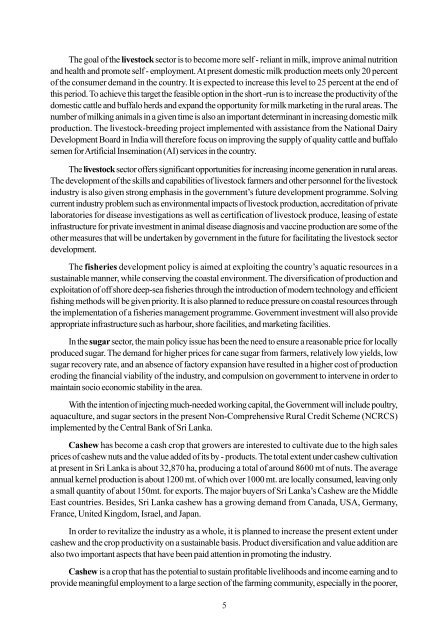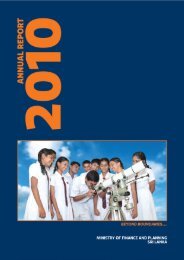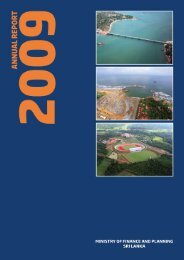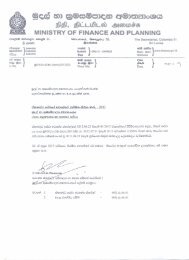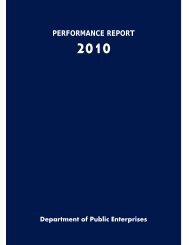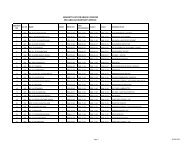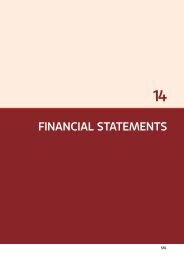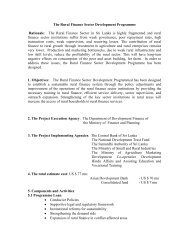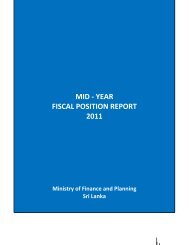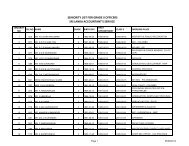Ten-year Horizon Development Framework - Ministry of Finance and ...
Ten-year Horizon Development Framework - Ministry of Finance and ...
Ten-year Horizon Development Framework - Ministry of Finance and ...
Create successful ePaper yourself
Turn your PDF publications into a flip-book with our unique Google optimized e-Paper software.
The goal <strong>of</strong> the livestock sector is to become more self - reliant in milk, improve animal nutrition<br />
<strong>and</strong> health <strong>and</strong> promote self - employment At present domestic milk production meets only 20 percent<br />
<strong>of</strong> the consumer dem<strong>and</strong> in the country It is expected to increase this level to 25 percent at the end <strong>of</strong><br />
this period To achieve this target the feasible option in the short -run is to increase the productivity <strong>of</strong> the<br />
domestic cattle <strong>and</strong> buffalo herds <strong>and</strong> exp<strong>and</strong> the opportunity for milk marketing in the rural areas The<br />
number <strong>of</strong> milking animals in a given time is also an important determinant in increasing domestic milk<br />
production The livestock-breeding project implemented with assistance from the National Dairy<br />
<strong>Development</strong> Board in India will therefore focus on improving the supply <strong>of</strong> quality cattle <strong>and</strong> buffalo<br />
semen for Artificial Insemination (AI) services in the country<br />
The livestock sector <strong>of</strong>fers significant opportunities for increasing income generation in rural areas<br />
The development <strong>of</strong> the skills <strong>and</strong> capabilities <strong>of</strong> livestock farmers <strong>and</strong> other personnel for the livestock<br />
industry is also given strong emphasis in the government’s future development programme Solving<br />
current industry problem such as environmental impacts <strong>of</strong> livestock production, accreditation <strong>of</strong> private<br />
laboratories for disease investigations as well as certification <strong>of</strong> livestock produce, leasing <strong>of</strong> estate<br />
infrastructure for private investment in animal disease diagnosis <strong>and</strong> vaccine production are some <strong>of</strong> the<br />
other measures that will be undertaken by government in the future for facilitating the livestock sector<br />
development<br />
The fisheries development policy is aimed at exploiting the country’s aquatic resources in a<br />
sustainable manner, while conserving the coastal environment The diversification <strong>of</strong> production <strong>and</strong><br />
exploitation <strong>of</strong> <strong>of</strong>f shore deep-sea fisheries through the introduction <strong>of</strong> modern technology <strong>and</strong> efficient<br />
fishing methods will be given priority It is also planned to reduce pressure on coastal resources through<br />
the implementation <strong>of</strong> a fisheries management programme Government investment will also provide<br />
appropriate infrastructure such as harbour, shore facilities, <strong>and</strong> marketing facilities<br />
In the sugar sector, the main policy issue has been the need to ensure a reasonable price for locally<br />
produced sugar The dem<strong>and</strong> for higher prices for cane sugar from farmers, relatively low yields, low<br />
sugar recovery rate, <strong>and</strong> an absence <strong>of</strong> factory expansion have resulted in a higher cost <strong>of</strong> production<br />
eroding the financial viability <strong>of</strong> the industry, <strong>and</strong> compulsion on government to intervene in order to<br />
maintain socio economic stability in the area<br />
With the intention <strong>of</strong> injecting much-needed working capital, the Government will include poultry,<br />
aquaculture, <strong>and</strong> sugar sectors in the present Non-Comprehensive Rural Credit Scheme (NCRCS)<br />
implemented by the Central Bank <strong>of</strong> Sri Lanka<br />
Cashew has become a cash crop that growers are interested to cultivate due to the high sales<br />
prices <strong>of</strong> cashew nuts <strong>and</strong> the value added <strong>of</strong> its by - products The total extent under cashew cultivation<br />
at present in Sri Lanka is about 32,870 ha, producing a total <strong>of</strong> around 8600 mt <strong>of</strong> nuts The average<br />
annual kernel production is about 1200 mt <strong>of</strong> which over 1000 mt are locally consumed, leaving only<br />
a small quantity <strong>of</strong> about 150mt for exports The major buyers <strong>of</strong> Sri Lanka’s Cashew are the Middle<br />
East countries Besides, Sri Lanka cashew has a growing dem<strong>and</strong> from Canada, USA, Germany,<br />
France, United Kingdom, Israel, <strong>and</strong> Japan<br />
In order to revitalize the industry as a whole, it is planned to increase the present extent under<br />
cashew <strong>and</strong> the crop productivity on a sustainable basis Product diversification <strong>and</strong> value addition are<br />
also two important aspects that have been paid attention in promoting the industry<br />
Cashew is a crop that has the potential to sustain pr<strong>of</strong>itable livelihoods <strong>and</strong> income earning <strong>and</strong> to<br />
provide meaningful employment to a large section <strong>of</strong> the farming community, especially in the poorer,<br />
5


